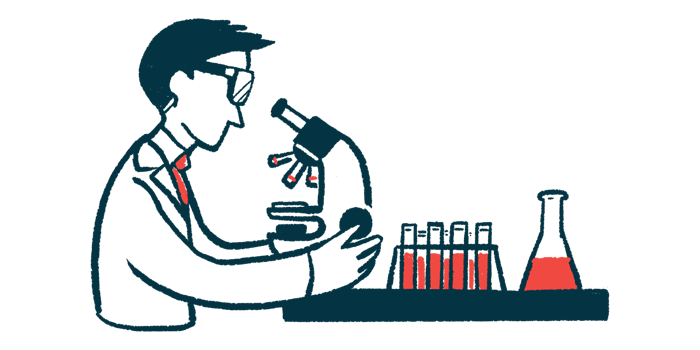Stem Cell Gene Therapy Blocks Anti-GAA Immune Response in Mice

Administrating a stem cell gene therapy before beginning enzyme-replacement therapy (ERT) prevented the development of antibodies against the acid alpha-glucosidase (GAA) enzyme, improved survival, and enhanced therapeutic benefits in a mouse model of Pompe disease, a recent study found.
“Together, this study indicates that [stem cell] gene therapy induces immune tolerance to GAA and that subsequent treatment with ERT is safe and efficacious, offering a promising scenario for the clinical development of … gene therapy for the treatment of Pompe disease,” the researchers wrote.
The study, “Lentiviral Gene Therapy Prevents Anti-Human Acid α-Glucosidase Antibody Formation in Murine Pompe Disease,” was published in the journal Molecular Therapy – Methods and Clinical Development.
The symptoms of Pompe disease are caused by mutations in the GAA gene, leading to a missing or less-effective GAA enzyme. As a result, a complex sugar called glycogen builds inside cells and disrupts their function.
Patients are treated with ERT to restore functional GAA levels. In the U.S., approved ERTs for Pompe include Lumizyme (alglucosidase alfa) and Nexviazyme (avalglucosidase alfa), both marketed by Sanofi Genzyme. But one drawback to ERT is that patients sometimes will develop antibodies against the lab-made treatment, which reduces its effectiveness and can pose a safety risk.
Blood (hematopoietic) stem cell gene therapies may be an alternative approach for treating Pompe patients. In brief, the approach involves delivering a healthy copy of the GAA gene, packaged into a viral carrier called a lentivirus, to hematopoietic stem cells. These stem cells, which give rise to virtually all mature blood cell types, then pass on this healthy GAA to their mature progeny, allowing them to produce a working GAA enzyme.
Previously, a research team showed that this stem cell gene therapy led to increased GAA activity, reduced glycogen accumulation, and improved heart and motor function in a mouse model of Pompe. Further, the treatment appeared to prevent the formation of antibodies against GAA induced by ERT.
The team now further investigated the effects of using both the stem cell therapy and ERT in a mouse model of Pompe.
The gene therapy procedure involves the extraction of stem cells from a donor mouse, which then are treated with the gene therapy in the lab. The recipient mice underwent a course of radiation therapy designed to kill off blood stem cells to “make room” for the genetically modified ones, and then received the gene therapy through a single injection in their tail.
Six weeks later, the mice began weekly ERT infusions (20 mg/kg) for 10 weeks.
Results showed that mice that did not receive the gene therapy developed high levels of antibodies against GAA, whereas the gene therapy was able to prevent the development of antibodies even at a low dose. The team also found that the gene therapy led to GAA expression in the thymus. Its expression in this immune system organ is essential for mediating immune tolerance toward the protein, the researchers said.
A 12-week delay before starting ERT after gene therapy was similarly able to prevent anti-GAA antibody formation, but waiting just one week led to the development of some low levels of antibodies, the researchers noted.
As expected, mice that did not receive the gene therapy experienced anaphylactic shock, a severe immune response leading to airway closure, and died starting after the third ERT dose. No mice survived past the fifth dose. In contrast, mice that received gene therapy either six or 12 weeks before starting ERT all survived for the entire 10-week ERT treatment protocol.
Mice that received gene therapy one week before a 14-week ERT treatment protocol also survived for the entire period, suggesting that while they did develop some low levels of antibodies, they were depleted enough to prevent anaphylactic shock.
Given the gene therapy’s ability to boost ERT tolerance, the team tested whether increased doses of ERT (100 mg/kg weekly) could be tolerated in the mice. The findings showed that even at these high doses, the gene therapy was able to prevent antibody formation.
While the gene therapy alone or in combination with ERT at 20 mg/kg led to some therapeutic benefits, combining it with the higher dose of ERT (100 mg/kg) led to a full correction of glycogen levels and completely restored motor performances.
“These results emphasize that [stem cell] mediated lentiviral gene therapy may not only serve as an alternative treatment option for Pompe disease, but also as an immunomodulatory approach to overcome the immunological complications associated with ERT,” the researchers wrote, adding that this may be particularly relevant for patients with infantile-onset Pompe, who are at the highest risk of developing anti-GAA antibodies.






